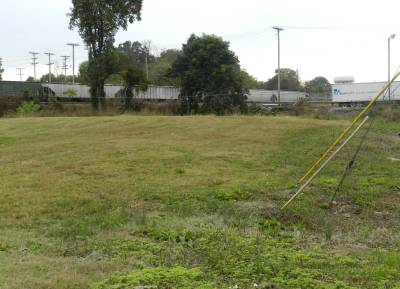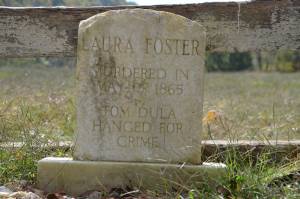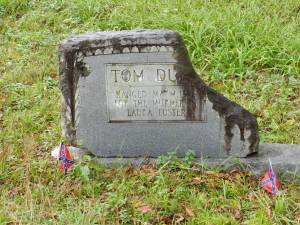Tom Dooley - An update: I
Since my last article on Tom Dooley was published, a few things has happened. I have visited Wilkes County once more, and this time I had the opportunity to take close up pictures of Tom's, as well as Laura Foster's graves - something I haven't been able to do until now.
A new book on the subject, "The True Story of Tom Dooley" by John E. Fletcher, with a foreword by Mrs. Edith Ferguson Carter, owner of Whippoorwill Academy and Village in Ferguson, has been published in 2013. I also finally got hold of a copy of Reverend Dr. Robert Isbell's "book", "The World of My Childhood" (actually a series of newspaper articles collected in a book).
I also got wiser on some, not really important but non the less interesting issues about the case, like where everyone actually lived and so on. Nothing that have changed my mind on what really happened though. This article is about some of the above. More will follow in later updates.
The place of execution

The photo on the left, is taken on the corner of Harrison Street and Railroad Avenue in Statesville. The old station must have been situated around where the Bartlett Milling Company truck is parked (extreme right of picture), and I imagine that the grassy area is a likely site of the gallows.
In my article The Story of Tom Dooley VII - Execution and aftermath I guessed that the gallows must have been placed somewhere near present days South Center Street, actually the southern end of South Center Street. I based this guess on information I received during my visit to Statesville in 2004, where I was told that the station was on the opposite side of the tracks, from what today is known as "The old railway Depot" on 111 Depot Lane. Later I have learned that this is not the case. The orginal railway station was actually placed around 300 yards northeast of the present "Old Railway Depot" that now houses the Statesville Housing Authorities - and Tom was executed just south of the building. Depending on how precise this direction is, it means that the place of excution must have been either near the corner of Jefferson Street and Washington Avenue or even more likely where the small gravel road, Railroad Avenue departs from Harrison Street, on the eastern side of Bartlett Milling Company, rather than on the western side as my first article indicated that it was. During my last visit in October 2013, I took pictures of the two possible sites, with the most likely site shown here.
Graves of Tom and Laura


Laura's tombstone (left) and Tom's (right). Laura's stone is found on her grave in Caldwell County, approximately 3.2 miles from the Wilkes/Caldwell county line using NC Route 268; 2.5 miles as the crow flies. Tom's stone is on his grave in an old Dula cemetery near Tom Dula Road (State Road 1164), approximately 1.2 miles from NC 268, not 1.5 miles as the historical marker indicates. Unlike Laura's grave, Tom's is not visible from the road. Both are on private property.
There is actually not much new on this subject except me being able to take close-ups of the two graves during my latest visit to the area. Both the stones have been erected many years after the two of them were buried. One thing I has always wondered though, was the wrong years on both stones. According to Laura's stone, she was killed in May 1865 - while Tom was still in POW camp in Maryland, and on Tom's stone the inscription tells, that he was hanged on May 1st, 1866 - almost a month before the murder was comitted!
I don't wonder any more though. I'm now certain that the wrong dates orginates from two articles in the "The World of My Childhood" series by Robert L. Isbell, published in the Lenoir paper, The News-Topic in the late nineteenforties and early nineteenfifties. In article 37 and 38, Dr. Isbell relates the Tom Dooley story, and he gives 1865 as the year of the murder and 1866 as the year of the execution. As the articles were published not long before the erection of the monuments, it's reasonable to believe that these articles were the source of the wrong dates. How Dr. Isbell could be that wrong is difficult to tell. He was the son of Tom's main pursuer, James Isbell, who of cause must have known the years in question, so it's likely to assume, that he didn't have the information from his father. In the articles he claims that he was well acquainted with Laura's father, who also must have known when his daughter was murdered and when the guilty party was executed. But apparently Isbell was not that well acquainted after all, as he didn't know the first name of Lauras father. He calls him Will, but claims that this is short for William, while it actually must have been short for Wilson. I will get back to this book in a later article as it is a great source to everyday life in Happy Valley in the years after the civil war.